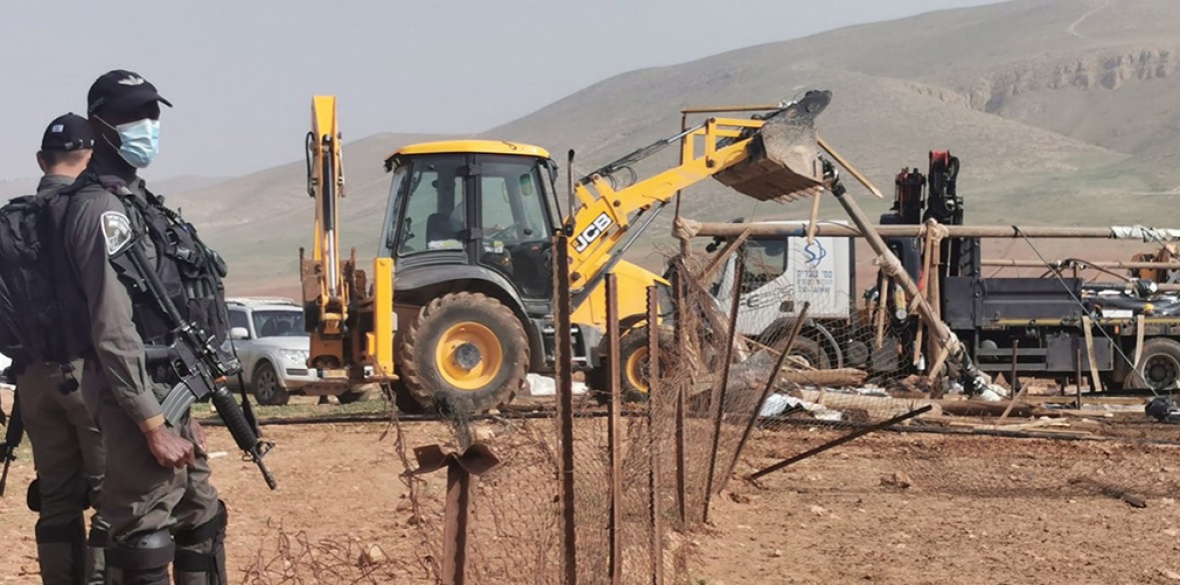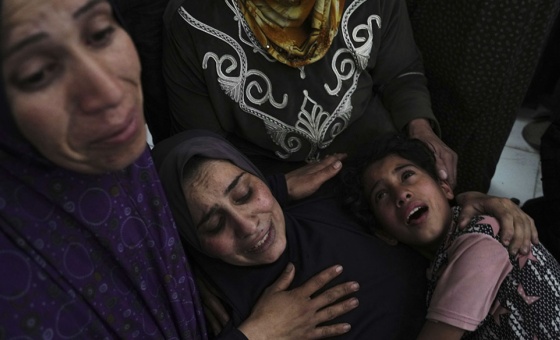This is the last article you can read this month
You can read more article this month
You can read more articles this month
Sorry your limit is up for this month
Reset on:
Please help support the Morning Star by subscribing here
THE Israeli-escalated home demolition against Palestinians in “Area C” has never taken a break since the start of 2021.
Through this, Israel seeks to expel Palestinians from their land.
The semi-nomadic community of Humsa, in the northern Jordan Valley, is one of the Israeli targets for forcible displacement.
This article discusses the recent Israeli demolition campaign against Humsa community, the legal status of the area, the resistance of Humsa residents through their semi-nomadic lifestyle and takeaway lessons from Humsa experience.
Humsa: terra nullius? Not at all
As part of the Israeli attempts to de jure annex the Jordan Valley, the 130 residents of Humsa have been subject to a brutal Israeli demolition campaign.
Since February 1, the Israeli occupation have demolished Humsa five times, leaving most of its residents homeless.
Om Ali, a 44-year-old mother of seven, narrated how their tented homes and animal shelters were razed to the ground on February 1.
“I was milking our sheep when the Israeli Civil Administration, Israeli military jeeps and bulldozers arrived in Humsa.
“My husband was out to sell dairy products. Israeli soldiers with their fingers on the trigger of their rifles ready to shoot us started yelling at us to evacuate our homes.
“They confiscated part of our property while the rest was destroyed to make sure that we do not rebuild our homes from the rubble.”
In the Jordan Valley and other parts of Area C, Israel adopts a doctrine of terra nullius, or land belonging to no-one, where land is considered empty of property rights. Therefore, Israel manipulated all of the Ottoman, Jordanian and British Mandate land laws to serve this doctrine.
Like other communities, Humsa has fallen prey to Israeli manipulation of laws. Israel considers Humsa a military firing range under the control of the state, where Palestinians’ presence is criminalised.
Fifty-five-year-old Abu Ahmad asserted that he was born in Humsa a year before the Israeli occupation of the area in 1967.
He says: “I have been a shepherd grazing the cattle in Humsa since I was a little boy.”
Although the laws that were in force before the Israeli occupation of the Jordan Valley rule that a community can claim a collective right to the land they have been grazing for years, Israel disregards this.
Lifestyle as resistance
While Israel treats the residents of Humsa as rootless nomads with no ownership right to their land, on the ground, Humsa inhabitants prove that their nomadic lifestyle is a form of resistance that strengthens their rootedness to the land.
Humsa residents live as shepherds, where they spend their time roaming the hills of the Jordan Valley.
This lifestyle has enabled them to gain extensive knowledge and experience regarding how to cope with natural and man-made hardships. This has fostered their connection to the land.
Yet their attachment to the land is not seen in organised, collective and confrontational resistance to the Israeli expulsion attempts.
Rather, the calm faces of the people of Humsa hide genuine rage and determination to stay on the land against all odds — which explains why they refuse to leave despite the fierce Israeli demolition practices.
We had a conversation with Harbi, a resident from Humsa, about how he is going to secure a shelter for his family and cattle after the Israeli occupation demolished their property.
He looked at us with a smiley face. Then he highlighted the hills surrounding Humsa, saying: “We know the area much better than our colonisers.”
His hand was pointing to some hidden caves that only long-standing shepherds in the area are aware of.
Sixteen-year-old Omar, who dropped out of school last year as he wanted to become a shepherd like his father, expressed his outrage at the repetitive Israeli demolition of his family’s property, saying: “The occupation wants us to leave and take over our land.
“If this is what they want, the war I am waging on them is to stay steadfast here. ‘Sumud’ [steadfastness] is our only weapon to continue existing in Humsa.”
When we asked Omar about the motive to maintain a physical presence amid Israeli “silent ethnic cleansing,” he replied: “In every time Israeli soldiers storm our community; they order us, ‘go to Ein Shebleh.’
“My father keeps saying we cannot go to Ein Shebleh because it is an area already inhabited and owned by other Palestinians.
“Also Ein Shebleh is an agricultural area, where it is hard to graze our cattle; in addition, open space for us and our cattle is limited there.”
It is clear from Omar’s testimony that the land of Humsa is basic to their economic survival, as well as to the social and cultural framework of their community.
As the semi-nomadic pastoral lifestyle of Humsa residents is a motivation for them to remain on their land, the Israeli occupation constantly attacks their lifestyle.
Om Ali emphasised this by stating that “the Israeli occupation waited for winter to come to start demolishing our property; because they know that this harms our livestock.
“The livestock are sensitive to the cold, where we risk losing them.”
The Israeli onslaught on the semi-nomadic lifestyle of Humsa seeks to replace it by landless and urbanised lifestyle.
Accordingly, Palestinians’ ability to live a traditional land-based semi-nomadic lifestyle is both a pre-colonial and anti-colonial phenomenon.
The residents of Humsa who appear to be passive, defeated and weak are able to disrupt Israeli expulsion attempts and, by implication, the Jewish-only settlement expansion project.
Humsa: a model to echo and preserve
The Israeli settlement expansion in Area C has shrunk the space available for Palestinians.
Many shepherds were forced to give up their traditional pastoral lifestyle and move to urban areas.
Since the signing of the Oslo Accords between Israelis and Palestinians in 1993, Western powers and the Palestinian Authority have championed the urbanisation of Palestinians.
This is seen in encouraging and bankrolling the increasing numbers of NGOs in Palestine.
Yet, the systematic urbanisation of Palestine proves to only serve the Israeli settlement expansion scheme.
This raises the question of how many Israeli land pillage schemes would Palestinians thwart if Humsa, an example of an indigenous connection to the land, is preserved and echoed in other threatened areas?
Manal Shqair is a Palestinian popular activist based in Palestine and is the advocacy and campaigning co-ordinator of Palestinian grassroots campaign Stop the Wall (www.stopthewall.org). Mahmoud Soliman is a Palestinian academic activist from the city of Bethlehem. He finished his PhD in peace and conflict resolution studies from Coventry University in April 2019. He is one of the co-founders of the Popular Struggle Co-ordination Committee (PSCC).











